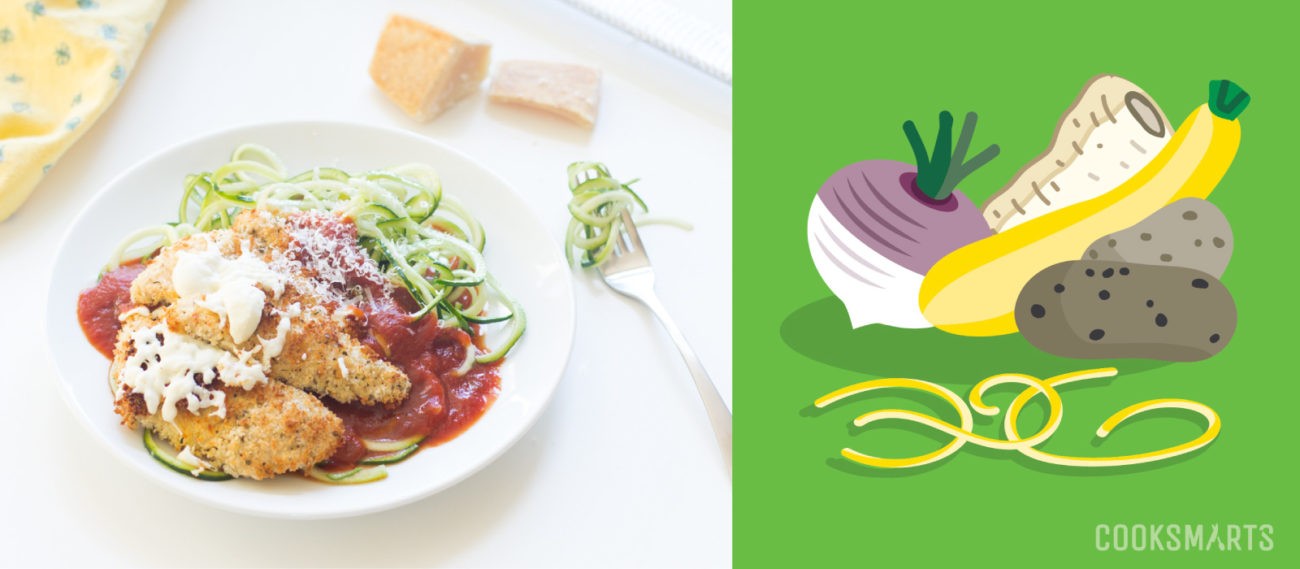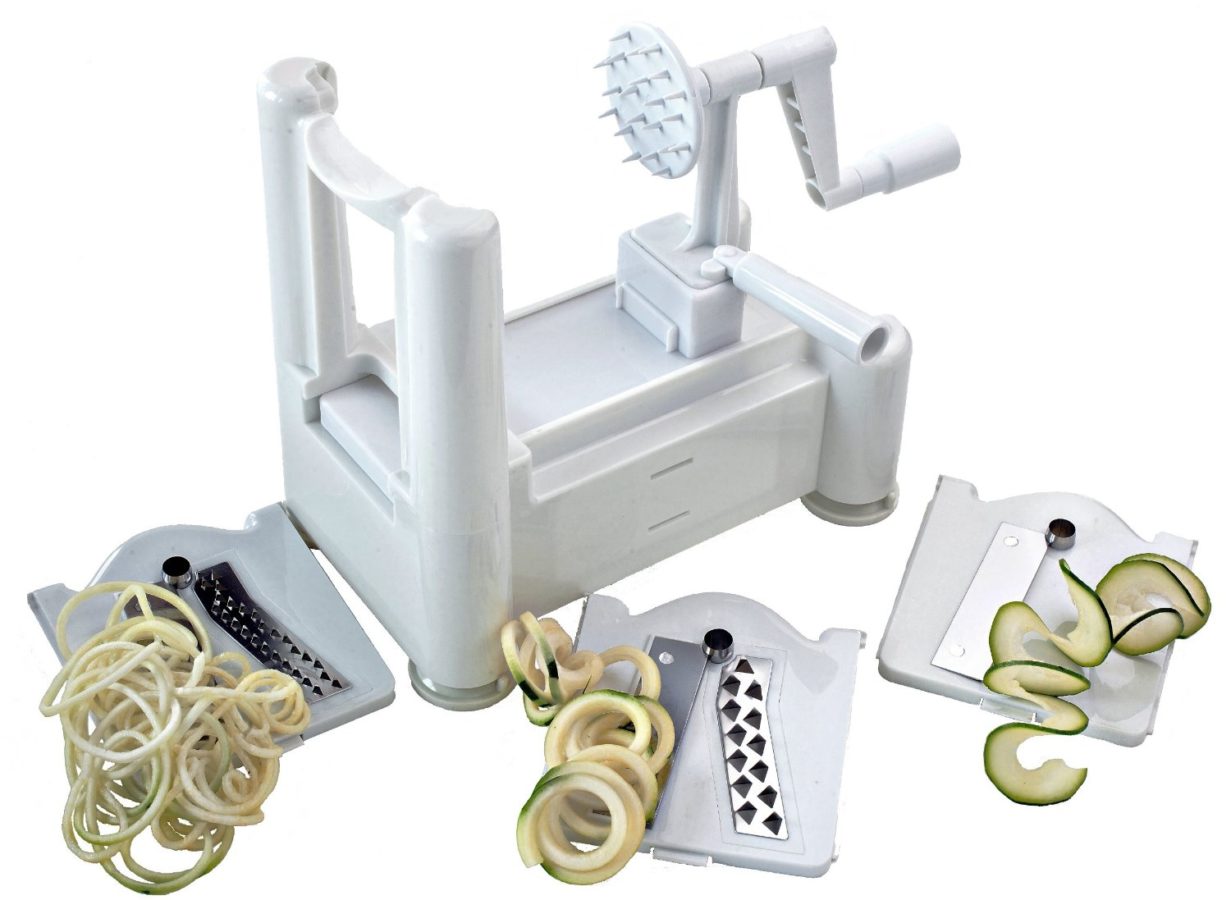Noodle-Fying Your Veggies is Fun and Healthy | #eatmoreveggies
Discover a fun way to #eatmoreveggies with our new video. Our cooking tips and ideas will show you the all the ways you can enjoy this different method of prepping veggies.
Last week, I sent out my 2015 wish for you. To help you transform this wish into reality, all this month I’ll be offering some creative and fun ways to #eatmoreveggies in 2015.
This week’s kick-off idea: Noodle-fy your veggies!
I know some of you recently received spiralizers for the holidays and may need some tips on how to use it. I’m not someone who has a lot of single-use gadgets in my kitchen, but I’m really glad I purchased this tool last year.
The truth is I’m a carb addict.
I would be happy eating some sort of noodle for every meal, but getting this spiralizer has allowed me to still get my noodle fix and eat more veggies while I’m at it.
(But don’t worry, I still indulge with regular ol’ noodles some of the time!)
Plus, making vegetable noodles is even more convenient when catering to different diets because just about all veggies are gluten-free and paleo friendly!


How to Use Your Spiralizer
Most spiralizers come with three different attachment blades:
- A thinner noodle that resembles the thickness of spaghetti. I use this one most often when substituting for an Italian or Asian noodle.
- A thicker spiral that resembles the thickness of bucatini (but not hollow). This attachment is best for making curly fries (remember, fries don’t just have to made of potatoes either!).
- A thinner ribbon that gives you a beautiful, delicate ribbon spiral. This is great for creating thinly sliced vegetables to incorporate into salads.
Once you select your blade, this video shows you how easy it is to use your spiralizer:
How to Make Vegetable Noodles with a Spiralizer
A spiralizer is a great tool to help you make vegetable noodles, which make a great paleo, gluten-free, or low-carb alternative to traditional pasta.
What to Noodle-fy & How to Cook Them
As a Noodle Substitute
- Use the thinner noodle blade and make Italian pasta dishes with: parsnips, potatoes, turnips / kohlrabi / rutabagas, sweet potatoes, zucchini
- Use the thinner noodle blade and make Asian stir-fry or soup noodles with: carrots, daikon radishes, potatoes, turnips, zucchini
How to cook: saute method
Add some cooking oil (we recommend grapeseed, avocado, or coconut) to a heated pan (like a skillet, frying pan, saute pan, or wok). Toss until tender but still rather crunchy since there will be some carryover cooking (i.e., the residual heat will continue to cook the veggies some).
Dense vegetables like potatoes and carrots will take longer to saute, while lighter veggies like zucchini will just take 2 to 4 minutes. If the pan ever looks too dry, you can always add a splash of water, broth / stock, or wine. Then eat just like a noodle – sauce it Italian style, add to an Asian soup, or add even more stir-fried vegetables to it.
How to cook: boil method
If you’re making an Italian marinara sauce or have a broth for soupy noodles, you can boil the veggie noodles directly in the sauce or soup, which will also impart more flavor into the sauce and soup. However, I recommend that if you choose this method to undercook the veggie noodles, because the hot sauce or soup will produce a lot of carryover cooking.
How to cook: microwave method
Place noodles in a microwave-safe dish. Cover with a wet paper towel and microwave 2 minutes at a time until veggies are tender but still crunchy. Just like mentioned with the saute method, denser, firmer vegetables will take longer to cook. If a lot of liquid formed, drain before serving or cooking with other items.
For Spiralized Veggie Fries
- Use thicker blade to create veggie fries with: carrots, jicama, potatoes, sweet potatoes, turnips / kohlrabi / rutabagas
How to cook: veggie fries
Heat oven to 425F (or 218C) degrees. Use scissors to snip spiralized veggies into shorter segments. Toss spiralized veggies with oil and spread onto a sheet pan. If it feels too crowded, bake in batches or use two sheet pans. Sprinkle with salt, pepper, and any desired spices. For ideas, check out our spice infographics. Bake for 20 to 30 minutes, until golden and crispy. Shake once midway through. Enjoy with your favorite condiments or dipping sauces!
For Raw Veggie Noodles or Salads
- Use thinner noodle blade to make cold noodles or make a veggie ‘noodle’ slaw with: carrots, cucumbers, jicama, zucchini
- Use ribbon blade to create delicate ribbons of these veggies and fruits to add to your salads: apples, carrots, cucumbers, pears, persimmons, zucchini
How to dress: raw veggie noodles / ribbons
Make a vinaigrette or other sauce and toss with noodles or ribbons. Salt and pepper to taste. Veggie noodles may need more marinating time (at least 30 minutes) in the fridge for more flavor.
What to Do With Scraps
The one downside of the spiralizer is that it leaves behind a tube-shaped piece of whatever you’re spiralizing. You can toss it but I like to save my produce scraps for homemade broth / stock. I keep a large Ziploc bag in my freezer and fill it with scraps from spiralizing or other prep.
Once I get a full bag, I dump it into my slow cooker with some salt and Bay leaves, cover with water, and then cook on low for 8 to 9 hours. If you have some animal bones, you can toss those into for a homemade stock.
Now go noodle-fy / spiralize!
I hope this post has been enough to convince you to get a spiralizer (~$30 on Amazon as of this post publish date). This is such a fun way to #eatmoreveggies, and I hope there are a lot of veggie noodles in your 2015 meals!
If you’re a part of our meal plan service, you’ll definitely be seeing a lot more veggie noodles in the paleo versions of our menu. This week we’re featuring zucchini noodles (aka zoodles) in a curry noodle soup and carrot noodles in a steak stir-fry!
If you want some help incorporating more veggie noodles into your cooking, definitely check out our meal plan service. We’ll be featuring our #eatmoreveggies ideas all month long! Or sign up for our newsletter below, and we’ll send you all our best cooking resources and tips to help you cook smarter.
